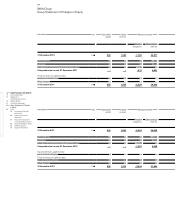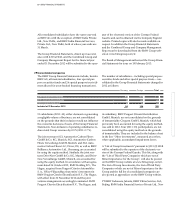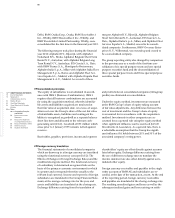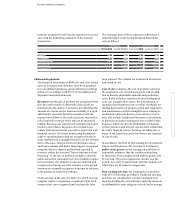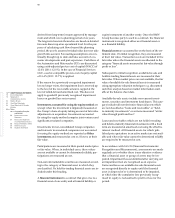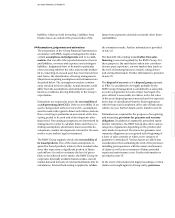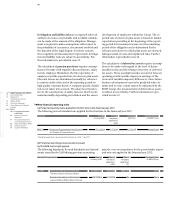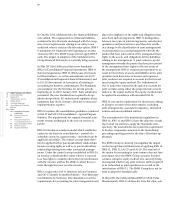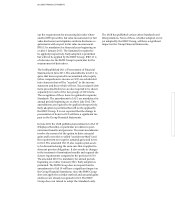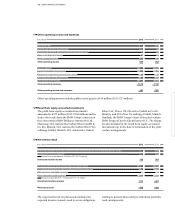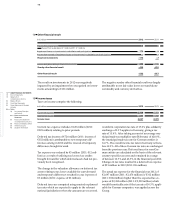BMW 2012 Annual Report Download - page 93
Download and view the complete annual report
Please find page 93 of the 2012 BMW annual report below. You can navigate through the pages in the report by either clicking on the pages listed below, or by using the keyword search tool below to find specific information within the annual report.
93 GROUP FINANCIAL STATEMENTS
With the exception of derivative financial instruments,
all receivables and other current assets relate to loans
and receivables which are not held for trading. All such
items are measured at amortised cost. Receivables with
maturities of over one year which bear no or a lower-
than-market interest rate are discounted. Appropriate
impairment losses are recognised to take account of all
identifiable risks.
Receivables from sales financing comprise receivables
from retail customer, dealer and lease financing.
Impairment losses on receivables relating to financial
services business are recognised using a uniform
methodology that is applied throughout the Group and
meets the requirements of IAS 39. This methodology
results in the recognition of impairment losses both on
individual assets and on groups of assets. If there is
objective evidence of impairment, the BMW Group rec-
ognises impairment losses on the basis of individual
assets. Within the retail customer business, the existence
of overdue balances or the incidence of similar events
in the past are examples of such objective evidence. In
the event of overdue receivables, impairment losses are
always recognised individually based on the length of
period of the arrears. In the case of dealer financing
receivables, the allocation of the dealer to a
correspond-
ing rating category is also deemed to represent objec-
tive
evidence of impairment. If there is no objective evi-
dence of impairment, impairment losses are recognised
on financial assets using a portfolio approach based on
similar groups of assets. Company-specific loss proba-
bilities and loss ratios, derived from historical data, are
used to measure impairment losses on similar groups of
assets.
The recognition of impairment losses on receivables
relating to industrial business is also, as far as possible,
based on the same procedures applied to financial
services business.
Impairment losses (write-downs and allowances) on re-
ceivables are always recorded on separate accounts and
derecognised at the same time the corresponding re-
ceivables are derecognised.
Items are presented as financial assets to the extent that
they relate to financing transactions.
Derivative financial instruments are only used within
the BMW Group for hedging purposes in order to re-
duce currency, interest rate, fair value and market price
risks from operating activities and related financing
requirements. All derivative financial instruments (such
as interest, currency and combined interest / currency
swaps, forward currency and forward commodity con-
tracts) are measured in accordance with IAS 39 at their
fair value, irrespective of their purpose or the intention
for which they are held. The fair values of derivative
financial instruments are measured using market infor-
mation and recognised valuation techniques. In those
cases where hedge accounting is applied, changes in
fair value are recognised either in income or directly in
equity under accumulated other equity, depending
on whether the transactions are classified as fair value
hedges or cash flow hedges. In the case of fair value
hedges, the results of the fair value measurement of the
derivative financial instruments and the related hedged
items are recognised in the income statement. In the
case of fair value changes in cash flow hedges which are
used to mitigate the future cash flow risk on a recog-
nised asset or liability or on forecast transactions, unre-
alised gains and losses on the hedging instrument are
recognised initially directly in accumulated other equity.
Any such gains or losses are recognised subsequently
in the income statement when the hedged item (usually
external revenue) is recognised in the income state-
ment. The portion of the gains or losses from fair value
measurement not relating to the hedged item is recog-
nised immediately in the income statement. If, con-
trary to the normal case within the BMW Group, hedge
accounting cannot be applied, the gains or losses from
the fair value measurement of derivative financial
in-
struments are recognised immediately in the income
statement.
In accordance with IAS 12 (Income Taxes), deferred
taxes are recognised on all temporary differences
between the tax and accounting bases of assets and lia-
bilities and on consolidation procedures. Deferred tax
assets also include claims to future tax reductions which
arise from the expected usage of existing tax losses
avail-
able for carryforward to the extent that future usage is
probable. Deferred taxes are computed using enacted
or planned tax rates which are expected to apply in the
relevant national jurisdictions when the amounts are
recovered.



